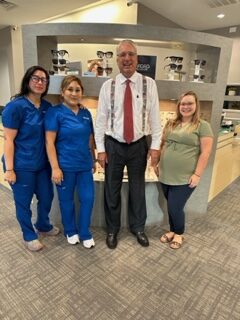
Dr. Krivacic with his staff. He says that giving patients a personalized experience, and giving employees a stake in practice success, are some of the ways to take a cue from Nike’s success with the Air Jordan shoe.
By Ken Krivacic, OD, MBA
June 21, 2023
Before I watched “Air,” I was expecting a movie about sports. What I watched instead was a movie that anyone in business can learn from. In fact, there are lessons from the film that we can use in our optometric practices.
“Air” chronicles the attempt by Nike to make a dent in the basketball shoe business back in the early eighties. Before they signed Michael Jordan to a contract, the basketball shoe market was dominated by Converse (53 percent) and Adidas (29 percent) with Nike being a distant third at 17 percent of the market. Nike was considering getting out of the basketball shoe market until Sonny Vaccaro, one of a group at Nike in charge of signing players, had the idea to risk their entire yearly player budget ($250,000 back in 1984), usually allocated to three players, on just one player – Michael Jordan.
The signing of Jordan skyrocketed Nike to the top of the basketball shoe market. Prior to his signing, the highest annual revenue generated from one shoe line was $3 million dollars. The year after Nike signed Jordan, his brand generated $162 million in revenue. Nike eventually went on to buy its rival Converse, and last year, revenue from the Jordan brand exceeded $4 billion.
What can we take away from the film to help us better manage and grow our practices? Here are a few lessons from “air” to use in your practice.
Take Risks
If you own your own practice, you have already taken a big risk by starting the practice. The start-up costs, the lack of any previous patient history and the ability to manage a business when most of us had no formal business training is daunting. Yet even after years in practice you still need to take risks. In the movie, Sonny Vaccaro wanted to spend the $250,000 Nike had budgeted for three players on one player who had never played a second in the NBA. It was a big risk yet he saw something in Michael Jordon that the other Nike exes didn’t, and ultimately, it worked out.
Just as in the movie, we owners need to still take risks: buy a new piece of equipment, hire more staff, put in a new line of frames and move your office when your space becomes too small.
Get Personal
In the film, Sonny breaks an unwritten rule and goes around the client’s attorney to visit him and his family in-person. He ultimately worked with Michael’s mother Delores since he knew she was the decision-maker in the family. The feeling was that Nike had no chance of signing Jordan and that he was heavily leaning toward Adidas. Sonny impressed her with his knowledge of Michael as a competitor and basketball player.
Don’t be afraid to get personal with your patients also. A review of their case history is important when it comes time to make recommendations about their vision and eye health. Engaging in personalized conversation with patients is an advantage you can have over many other practices that put an emphasis on patient volume and speed versus in-depth interactions. You are more likely to be the same doctor to see that patient year after year in an independent practice as opposed to many other settings where the doctor/patient relationship is less likely to be stable.
Know Your Competition
In the same initial conversation Sonny had with Delores, he talks about the sales pitch she can expect from his competitors Converse and Adidas. The movie depicts this as going almost exactly as he predicted.
In practice, you should know who your competition is and how they operate. Let patients know what to expect when they shop around. For example, online contact-lens sales sites advertise a very low per box price, but then hit the customer with a processing fee at the end of the transaction that can make their price almost the same as yours. Be sure to let your patients know that. Too often the perception is that independent practices are priced way above what they can get elsewhere.
Other Articles to Explore
Cater the Product to Your Client – “A shoe is just a shoe until somebody steps into it”
One of the main selling points for Nike was that they designed a shoe around Michael Jordan as opposed to the competitors at the time that designed shoes and then had their athletes promote them. This helped “sell” Nike to Jordan and was instrumental to him signing with Nike.
What can your practice do to cater to your patients?
In the contact-lens area of your practice, strive to fit more difficult cases – multifocal, keratoconus, Ortho-K, etc. Not only does that separate you from the average practice, but all those products require a more involved fitting and are custom to that patient.
In the optical, strive to carry a few frame lines that set you apart and are not the standard found at most other optical retailers. One of my favorite lines from the film was when Sonny was pitching Nike to the Jordans and said, “A shoe is just a shoe until someone steps into it.” We should have that same philosophy in our practices and replace that line with: “A frame is just a frame until someone puts it on.”
In the clinical side of the practice, offer specialty evaluations such as dry eye, glaucoma, low vision, sports vision, etc.
Share the Wealth
Finally, in the 30+ years of managing our practice, one of the things that helped us grow to generating $4 million+ annually was a motivated staff. Figuring out how to motivate was always a huge challenge. One of the things that helped was a bonus plan whereby our staff could participate in the profits of the practice. It was a plan that evolved over the years, but basically, it paid the staff a percentage of profits over and above their base pay.
In the movie, Delores agrees to have Michael sign with Nike for the $250,000, but then also said he needs a percentage of sales. In 1984, this had not been done before. After much discussion, Phil Knight, the founder and CEO of Nike, relented and agreed. It was a decision that has been tremendously profitable for both sides. Both Jordan and Nike had a vested interest in selling the shoes.
Can you do the same in your practice? I believe you can, and I think both sides can benefit. The employee has as much of a vested interest in the practice doing well as you do as owner. The percentage can be small – 1-2 percent of monthly profits. I recommend making the extra bonus a percentage of profits, and not just sales. Be fair. Share information with those involved on revenue as well as cost. A great resource is the book, “The Great Game of Business” by Jack Stack. Open-book management can scare some owners, but if managed properly, can be rewarding for all involved.
If you haven’t seen it yet, watch “Air.” Learn from others what can be done to make a business survive and thrive. Remember: “A practice is just a practice until someone steps into it.”
 Ken Krivacic, OD, MBA, practices at Las Colinas Vision Center in Irving, Texas, now a MyEyeDr. practice. . To contact him: kkrivacic@aol.com.
Ken Krivacic, OD, MBA, practices at Las Colinas Vision Center in Irving, Texas, now a MyEyeDr. practice. . To contact him: kkrivacic@aol.com.

























